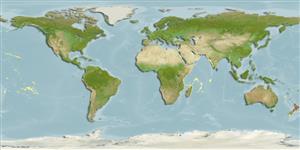Gastropoda |
Cycloneritida |
Neritidae
Environment: milieu / climate zone / depth range / distribution range
Ecology
Benthic. Subtropical
Indo-Pacific.
Length at first maturity / Size / Weight / Age
Maturity: Lm ? range ? - ? cmmax. reported age: 6 years (Ref. 8702)
Found in intertidal reefs and boulders (Ref. 337). Abundantly living on rocks between tide-marks, most frequent at half-tide mark or higher (Ref. 88739). Members of the family Neritidae are herbivorous, grazing by night at low tide on fine algae and detritus covering the bottoms where they live (Ref. 349).
Life cycle and mating behavior
Maturity | Reproduction | Spawning | Eggs | Fecundity | Larvae
Members of the order Neritopsina are mostly gonochoric and broadcast spawners. Life cycle: Embryos develop into planktonic trocophore larvae and later into juvenile veligers before becoming fully grown adults.
Brook, F.J. 1998 The coastal molluscan fauna of the northern Kermadec Islands, Southwest Pacific Ocean. Journal of the Royal Society of New Zealand 28(2):185-233. (Ref. 337)
IUCN Red List Status
(Ref. 130435: Version 2025-1)
CITES status (Ref. 108899)
Not Evaluated
Not Evaluated
Threat to humans
Harmless
Human uses
| FishSource |
Tools
More information
Trophic EcologyFood items (preys)
Diet composition
Food consumption
Predators
Life cycleReproductionMaturityFecunditySpawningEggsEgg developmentLarvae PhysiologyOxygen consumption
Human RelatedStamps, coins, misc.
Internet sources
Estimates based on models
Preferred temperature
(Ref.
115969): 15.9 - 28.2, mean 23.2 (based on 210 cells).
